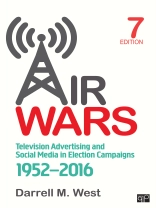Tracing the evolution of political advertising from 1952 through 2016, Darrell M. West returns with his much anticipated
Seventh Edition of
Air Wars: Television Advertising and Social Media in Election Campaigns, 1952-2016. Integrating the latest data and key events from the 2016 campaigns—including the most provocative presidential campaign in recent decades and the surprising victory of Donald Trump—West provides in-depth examination and insight into how candidates plan and execute advertising and social media campaigns, how the media covers these campaigns, and how American voters are ultimately influenced by them.
This
new edition includes coverage of social media campaigning, nano-targeting strategies in a fragmented electorate, and thorough analysis of the 2016 presidential campaign, from the candidates’ use of Twitter to concerns over falsehoods and deception, the impact of ads and debates on candidate perceptions, and the risks to democratic elections from new campaign developments.
Innehållsförteckning
Tables
Preface
Pictorial History
1. The History of Communications
From Newspapers and Television to the Internet and Social Media
Broadcasting Strategies
Narrowcasting
Microcasting
Nanocasting
Conclusion
2. Effective Ads and Social Media Promotion
Principles of Advertising
Production Techniques
The Role of Money and Super PACs
Effective Tweeting
Third-Party Validation
Conclusion
3. Buying Air Time and Using Social Media
The Strategies of Ad Buying
The Study of Ad Buys
Ad Frequency and Diversification
Vapor Ads
Social Media Outreach
Targeting Strategies
Conclusion
4. Messages
Substantive Content
Prominent Ads
The Paucity of Policy Appeals
Shifts Over Time
The Rise of Internet Sites
The Rise of Negative Advertising
The Objects of Negativity
Conclusion
5. Media Coverage
The Increasing Coverage of Ads
Horse-Race Coverage of Ads
“Daisy, ” “Daisy II, ” and the “Revolving Door”
Swift Boat Veterans Ads
2008 Ads
2012 Ads
2016 Ads
Conclusion
6. Learning About the Candidates
Citizens’ Knowledge and Evaluations of Candidates
The Impact of the Campaign
Ads and the Vote
Conclusion
7. Setting the Agenda
The Media’s Role in Agenda Setting
Policy and Campaign Components of the Agenda
The Influence of Individual Ads
A Fixed Agenda
A Fluid Agenda
It’s Still the Economy, Stupid!
Shifting the Focus
A Chaotic World
Conclusion
8. Playing the Blame Game
Blame Dukakis
Blame Bush
Blame Terrorists
Blame Bush and Mc Cain
Blame Romney
Blame the Establishment
Conclusion
9. Communications in Congressional Elections
Features of Congressional Campaigns
Historical Congressional Ads
Clinton Versus Giuliani and Lazio in 2000
2008 Senate Campaigns
2012 House and Senate Campaigns
2016 House and Senate Campaigns
Conclusion
10. Communications and Democratic Elections
Democratic Expectations
The Risk of Manipulation
The Importance of Fact-Checking
Lessons of Campaign Communications
Slicing and Dicing the Electorate
What Can Be Done
Conclusion
Appendix: Memorable Ads, 1984–2016
Notes
Index
About the Author
Om författaren
Darrell M. West is the Vice President of Governance Studies and Director of the Center for Technology Innovation at the Brookings Institution in Washington, D.C. He is the author of 22 books, including Megachange: Economic Disruption, Political Upheaval, and Social Strife in the 21st Century and Billionaires: Reflections on the Upper Crust.












